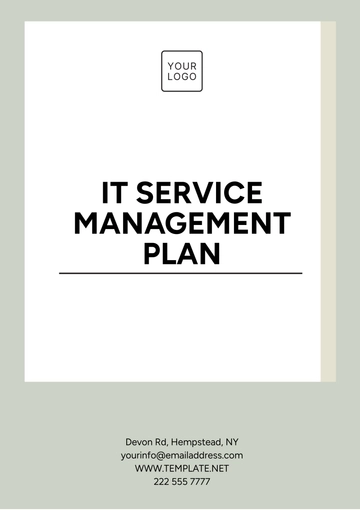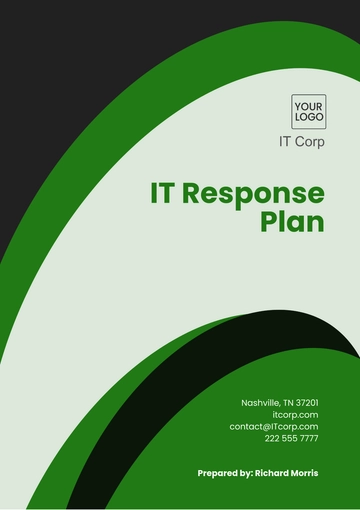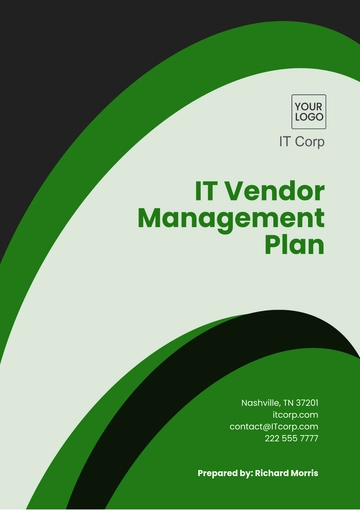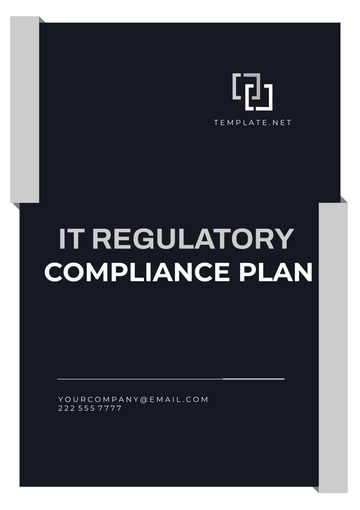Free IT Regulatory Compliance Plan
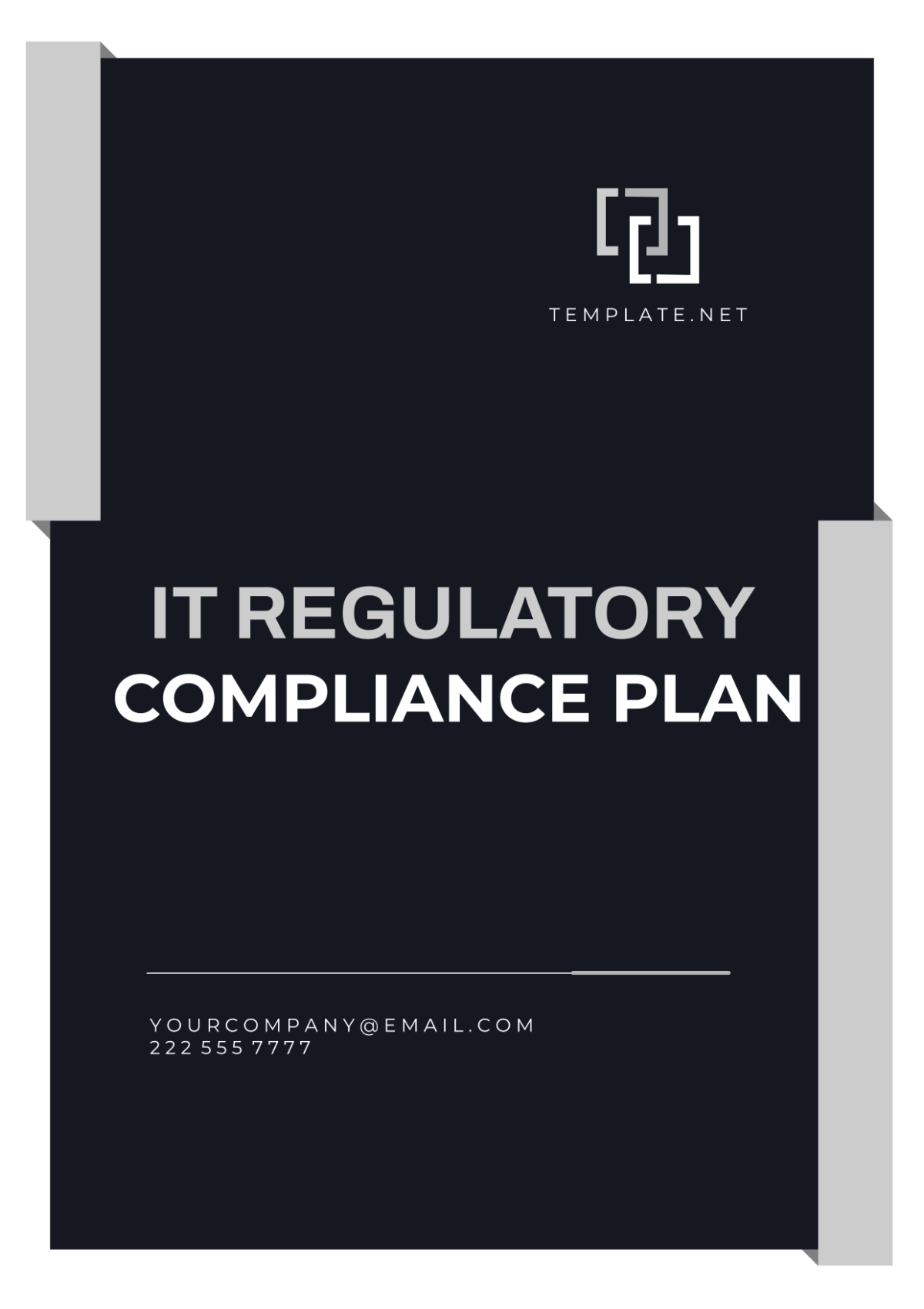
1. Introduction
Overview of IT Regulatory Compliance:
The IT Regulatory Compliance Plan outlines the measures taken by [Your Company Name] to ensure adherence to relevant regulations, standards, and guidelines in managing its IT systems.
Importance of Compliance in IT Systems:
Compliance is crucial for protecting sensitive data, maintaining trust with stakeholders, and avoiding legal repercussions.
Scope of the Compliance Plan:
This plan covers all IT systems, processes, and personnel within [Your Company Name]
2. Regulatory Framework
Identification of Relevant Regulations, Standards, and Guidelines:
GDPR, HIPAA, PCI DSS, ISO 27001.
Description of Applicable Laws:
GDPR: Protects personal data and privacy.
HIPAA: Ensures the security and privacy of healthcare information.
PCI DSS: Safeguards credit card data.
ISO 27001: Provides a framework for information security management.
Explanation of Regulatory Requirements:
Compliance with these regulations involves implementing security controls, safeguarding data, and ensuring privacy.
3. Governance Structure
Establishment of Compliance Governance Team:
The Compliance Governance Team comprises representatives from IT, legal, and senior management.
Roles and Responsibilities of Compliance Officers:
Compliance Officers oversee policy implementation, conduct risk assessments, and ensure ongoing compliance.
Reporting Structure for Compliance Issues:
Compliance issues are reported to the Compliance Officer, who escalates as necessary to senior management.
4. Risk Assessment
Conducting Regular Risk Assessments:
Quarterly risk assessments are conducted to identify and prioritize IT risks.
Identification of IT Risks and Vulnerabilities:
Risks include data breaches, system vulnerabilities, and non-compliance with regulations.
Evaluation of Impact and Likelihood of Risks:
Risks are evaluated based on their potential impact on data security and regulatory compliance.
5. Policies and Procedures
Development of IT Compliance Policies:
Policies cover data classification, access controls, incident response, and employee training.
Implementation of Procedures for Compliance Monitoring:
Procedures include regular audits, security assessments, and monitoring of access logs.
Communication of Policies to Relevant Stakeholders:
Policies are communicated through employee training sessions, policy manuals, and internal communications.
6. Controls and Safeguards
Implementation of Access Controls:
Access controls restrict unauthorized access to sensitive data and systems.
Encryption of Sensitive Data:
All sensitive data is encrypted both in transit and at rest to prevent unauthorized access.
Regular Security Patch Management:
Security patches are applied promptly to mitigate vulnerabilities and reduce the risk of cyberattacks.
7. Data Protection
Measures for Data Integrity:
Data integrity is maintained through regular backups, data validation checks, and access controls.
Backup and Recovery Procedures:
Regular backups are conducted, and recovery procedures are tested periodically to ensure data availability.
Data Retention Policies:
Data retention policies are established to ensure compliance with legal requirements and minimize data storage costs.
8. Training and Awareness
Provision of Regular Training on IT Compliance:
Employees receive annual training on IT security best practices, data protection, and regulatory compliance.
Awareness Programs for Employees:
Awareness programs include phishing simulations, cybersecurity workshops, and email reminders on IT policies.
Testing and Certification Programs:
Employees undergo testing and certification to validate their understanding of IT compliance requirements.
9. Incident Response
Development of Incident Response Plan:
An incident response plan outlines procedures for detecting, responding to, and mitigating cybersecurity incidents.
Procedures for Reporting Security Incidents:
Employees are instructed to report security incidents to the IT department immediately for investigation and response.
Post-Incident Analysis and Remediation:
After an incident, a post-incident analysis is conducted to identify root causes and implement corrective actions.
10. Auditing and Monitoring
Regular Internal Audits of IT Systems:
Internal audits are conducted annually to assess compliance with policies and regulations.
External Audits by Third-Party Agencies:
Third-party auditors are engaged biennially to perform independent assessments of IT compliance.
Continuous Monitoring of Compliance Status:
IT systems are continuously monitored for compliance deviations and security threats using automated tools and manual reviews.
11. Documentation and Record Keeping
Maintenance of Compliance Documentation:
All compliance-related documents, including policies, procedures, and audit reports, are maintained in a centralized repository.
Record Keeping of Compliance Activities:
Records of compliance activities, such as risk assessments, training sessions, and incident response actions, are documented for future reference.
Documented Evidence of Compliance Efforts:
Documentation provides evidence of [Your Company Name]'s commitment to compliance and assists in demonstrating regulatory compliance to auditors and regulators.
12. Continuous Improvement
Feedback Mechanisms for Process Improvement:
Feedback from audits, incident response exercises, and employee surveys is used to identify areas for improvement.
Review and Update of Compliance Plan:
The Compliance Plan is reviewed annually and updated as needed to reflect changes in regulations, technology, and business processes.
Adoption of Best Practices and Industry Standards:
[Your Company Name] actively monitors industry best practices and standards to incorporate into its compliance framework.
13. Conclusion
Recap of Key Points
The IT Regulatory Compliance Plan ensures [Your Company Name]'s adherence to relevant regulations, standards, and guidelines, safeguarding data and maintaining compliance.
Commitment to Continuous Compliance
[Your Company Name] is committed to maintaining a culture of compliance and continuously improving its IT regulatory compliance practices.
14. Signature
This IT Regulatory Compliance Plan has been reviewed and approved by the undersigned Compliance Officer on behalf of [Your Company Name].

[Your Name]
Compliance Officer
Date: [Date]
- 100% Customizable, free editor
- Access 1 Million+ Templates, photo’s & graphics
- Download or share as a template
- Click and replace photos, graphics, text, backgrounds
- Resize, crop, AI write & more
- Access advanced editor
Discover unparalleled ease in crafting your IT Regulatory Compliance Plan with Template.net. Our meticulously designed template is not just editable but also fully customizable to suit your unique requirements. Seamlessly navigate through the intricacies of compliance with ease, thanks to our intuitive Ai Editor Tool. Simplify your compliance journey today with Template.net.
You may also like
- Finance Plan
- Construction Plan
- Sales Plan
- Development Plan
- Career Plan
- Budget Plan
- HR Plan
- Education Plan
- Transition Plan
- Work Plan
- Training Plan
- Communication Plan
- Operation Plan
- Health And Safety Plan
- Strategy Plan
- Professional Development Plan
- Advertising Plan
- Risk Management Plan
- Restaurant Plan
- School Plan
- Nursing Home Patient Care Plan
- Nursing Care Plan
- Plan Event
- Startup Plan
- Social Media Plan
- Staffing Plan
- Annual Plan
- Content Plan
- Payment Plan
- Implementation Plan
- Hotel Plan
- Workout Plan
- Accounting Plan
- Campaign Plan
- Essay Plan
- 30 60 90 Day Plan
- Research Plan
- Recruitment Plan
- 90 Day Plan
- Quarterly Plan
- Emergency Plan
- 5 Year Plan
- Gym Plan
- Personal Plan
- IT and Software Plan
- Treatment Plan
- Real Estate Plan
- Law Firm Plan
- Healthcare Plan
- Improvement Plan
- Media Plan
- 5 Year Business Plan
- Learning Plan
- Marketing Campaign Plan
- Travel Agency Plan
- Cleaning Services Plan
- Interior Design Plan
- Performance Plan
- PR Plan
- Birth Plan
- Life Plan
- SEO Plan
- Disaster Recovery Plan
- Continuity Plan
- Launch Plan
- Legal Plan
- Behavior Plan
- Performance Improvement Plan
- Salon Plan
- Security Plan
- Security Management Plan
- Employee Development Plan
- Quality Plan
- Service Improvement Plan
- Growth Plan
- Incident Response Plan
- Basketball Plan
- Emergency Action Plan
- Product Launch Plan
- Spa Plan
- Employee Training Plan
- Data Analysis Plan
- Employee Action Plan
- Territory Plan
- Audit Plan
- Classroom Plan
- Activity Plan
- Parenting Plan
- Care Plan
- Project Execution Plan
- Exercise Plan
- Internship Plan
- Software Development Plan
- Continuous Improvement Plan
- Leave Plan
- 90 Day Sales Plan
- Advertising Agency Plan
- Employee Transition Plan
- Smart Action Plan
- Workplace Safety Plan
- Behavior Change Plan
- Contingency Plan
- Continuity of Operations Plan
- Health Plan
- Quality Control Plan
- Self Plan
- Sports Development Plan
- Change Management Plan
- Ecommerce Plan
- Personal Financial Plan
- Process Improvement Plan
- 30-60-90 Day Sales Plan
- Crisis Management Plan
- Engagement Plan
- Execution Plan
- Pandemic Plan
- Quality Assurance Plan
- Service Continuity Plan
- Agile Project Plan
- Fundraising Plan
- Job Transition Plan
- Asset Maintenance Plan
- Maintenance Plan
- Software Test Plan
- Staff Training and Development Plan
- 3 Year Plan
- Brand Activation Plan
- Release Plan
- Resource Plan
- Risk Mitigation Plan
- Teacher Plan
- 30 60 90 Day Plan for New Manager
- Food Safety Plan
- Food Truck Plan
- Hiring Plan
- Quality Management Plan
- Wellness Plan
- Behavior Intervention Plan
- Bonus Plan
- Investment Plan
- Maternity Leave Plan
- Pandemic Response Plan
- Succession Planning
- Coaching Plan
- Configuration Management Plan
- Remote Work Plan
- Self Care Plan
- Teaching Plan
- 100-Day Plan
- HACCP Plan
- Student Plan
- Sustainability Plan
- 30 60 90 Day Plan for Interview
- Access Plan
- Site Specific Safety Plan

